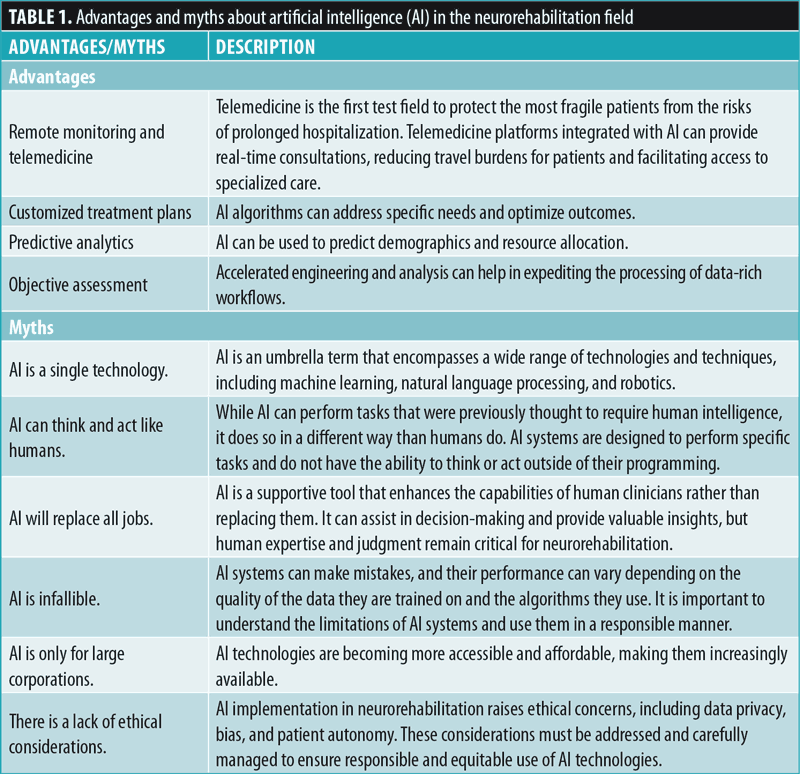
by Nicola Fiorente, MD; Sepehr Mojdehdehbaher, BSc; and Rocco Salvatore Calabrò, MD, PhD
Dr. Fiorente is with Polimedica Fisio and Sport in Cittadella (PD), Italy. Dr. Mojdehdehbaher is with Engineering Department, University of Messina in Messina, Italy. Dr. Calabrò is with IRCCS, Centro Neurolesi “Bonino-Pulejo” in Messina, Italy.
Funding: No funding was provided for this article.
Disclosures: The authors have no conflicts of interest relevant to the content of this article.
Innov Clin Neurosci. 2024;21(1–3):10–12.
Abstract
Artificial intelligence (AI) encompasses computer systems that mimic human cognitive functions, performing tasks such as learning, reasoning, problem solving, and decision-making. Neurorehabilitation is a specialized healthcare field aiding individuals with neurological injuries, employing various therapies to restore motor skills and cognitive function, enhancing their quality of life. The integration of AI in neurorehabilitation holds great promise, but it is crucial to approach this technology with a clear understanding of its capabilities and limitations. AI can enhance assessment, diagnosis, and personalized treatment plans, but it should complement, rather than replace, human healthcare providers. Additionally, ethical considerations must be at the forefront of AI implementation in the field of neurorehabilitation to ensure that patient wellbeing is prioritized.
Keywords: Innovation technology, artificial intelligence, neurological disorders, rehabilitation
As Marx and Engels wrote in the 19th century, “a specter is haunting” the world, or, in other words, a new system of thought that aims to “profoundly change everyday life.”1 In the last decade, artificial intelligence (AI) has emerged as such a system. AI is an unavoidable topic in popular media, the government of states and companies, and research and clinical settings. The risk of being influenced by confused reminiscences of the darkest science fiction prophecies of the past is real for nonspecialists, and policy makers are often among them.
The English Oxford Living Dictionary defines AI as “The theory and development of computer systems able to perform tasks normally requiring human intelligence, such as visual perception, speech recognition, decision-making, and translation between languages.”2 Therefore, AI can be considered a subfield of computer science, and it concerns how machines can imitate human intelligence. AI should be human-like “rather than becoming human,”2 a principle that might reassure those who are wary of the technology and allow our society to consider AI as a data science.
Neurorehabilitation is a complex medical process that aims to aid in the recovery from a nervous system injury and to minimize and/or compensate for any functional alterations resulting from it. Most of its rehabilitative services are typically furnished for inpatients in neurorehabilitation wards, especially for brain and spinal cord injuries, or outpatients. However, continuity of care means that patients should also be treated at home to further improve or potentiate functional outcomes.3
COVID-19 moved like a tornado, making everything more complex and urgent, including in the neurorehabilitation field. The outbreak of COVID-19 disrupted workflows in healthcare systems around the world.4 In several countries, neurorehabilitation units had to reduce their bed numbers to allow doctors and nurses to work in intensive care units or dedicated wards to isolate and care for patients with COVID-19.5 In Europe, new admissions to neurorehabilitation wards were suspended or temporarily reduced; then, scrupulous pre-admission screenings to test for COVID-19 were implemented, which also differentiated the pathways of patients who tested negative.4,5
The COVID-19 pandemic has forced healthcare systems in the United States (US) and Europe to push the accelerator on the use of technologies in neurorehabilitation, including telerehabilitation,6 that are increasingly supplemented with AI to treat more patients, treat them at home, and make the most of economic resources.
A recent editorial by Newman-Griff et al7 discussed studies presenting valuable insights into the range of health information related to human function and disability, as well as the role of AI technologies in helping to better collect, analyze, and report function and disability information. The authors showed the opportunities and challenges related to the potential of AI technologies to help analyze and use information on function and disability. They also highlighted essential applications of AI in tasks such as information extraction, classification, and prediction in this field.7
These latter applications might be very useful in neurorehabilitation, as rapid and proper extraction and analysis of clinical data might help physicians to better classify patient disability and outcomes to predict, for example, who might benefit more from intensive and innovative technology in rehabilitation, which patients with mild cognitive impairment (MCI) might convert into Alzheimer’s disease,8 or how many patients with stroke will have cognitive deficit.9 Through the analysis of a patient’s medical history, physical capabilities, and progress, AI algorithms can dynamically adapt and optimize treatment strategies to cater to individual needs, leading to more effective outcomes.
AI-facilitated brain–machine interfaces could help people with disabilities interact with their environments. With AI-facilitated sensory substitution, it will be possible for people with severe motor disabilities to use brain signals to operate a robotic arm or neural prosthesis.10 Furthermore, AI-driven assistive devices and rehabilitation robots can offer valuable support to individuals with neurological impairments, aiding in the recovery of motor skills and independence. These devices adapt to a patient’s progress, providing real-time feedback and guidance during rehabilitation exercises. Moreover, AI can enhance neurorehabilitation by crafting personalized treatment plans.
There are some fictions and misconceptions about AI, including the beliefs that there is a lack of ethical and privacy considerations, that AI will provide instant and miraculous cures, and that AI might completely replace human therapists.11 AI in neurorehabilitation has sparked ethical concerns related to data security and algorithm transparency, as it is vital to safeguard patient rights and privacy. AI, while valuable, does not offer instant cures for neurological conditions. Neurorehabilitation is a gradual, human-centric process that requires time and dedication from patients and healthcare professionals. Finally, AI complements, but cannot replace, the essential role of human caregivers, who provide empathy and personalized care.12 Table 1 shows the advantages and myths surrounding the growing use of AI in the neurorehabilitation field.

The contribution of AI in neurorehabilitation cannot be isolated from the more general context of AI. International organizations and the creators of various AI systems should collaborate to explore and explain the pros and cons of AI technologies, as well as to determine any action that is needed to guide the process of AI implementation. The pressure for regulatory and sanction interventions clashes with the natural freedom of companies, the market, and researchers, who are the real explorers of the potential of AI. The creation of international clinical protocols that consider the ongoing debate is a step in this direction. The World Economic Forum in June 2023 discussed the most widespread and insidious type of AI—generative AI. The Presidio Recommendations on Responsible Generative AI13 is a good starting point for dealing with generative AI, and its 30 recommendations deserve a reflection that goes beyond generative AI and quickly reaches the world of neurorehabilitation.
Generative AI can be used as a powerful search engine by those who draft research (including studies in the neurorehabilitation field), freeing energy for activities of exclusive relevance to humans. However, generative AI can also flood magazines with generated articles that surround a few mediocre data points with the thousands of words produced by one of the many large language models (LLMs) in circulation. The recommendations of the international authorities stem from the need to safeguard the quality of scientific publications, in neurorehabilitation and other fields of study.
Vigilance, ethics, and education of the new generations are then fundamental to prevent AI from overcoming the human brain. “Machines will not replace physicians, but physicians using AI will soon replace those not using it,” Antonio Di Ieva, neurosurgeon at Macquarie University, Sydney, wrote ironically in a balanced letter that appeared in The Lancet.14
In conclusion, AI is a growing and intriguing tool to apply in the field of neurorehabilitation, but its use should be cautious and well pondered, especially when dealing with function and disability. AI should only be adopted as an integral part of a neurorehabilitation’s armamentarium when there is evidence that it leads to better outcomes and reduces costs. Time alone will tell if AI in neurorehabilitation will be a bane or a boon, given that today we are just in a stage of transition. Nonetheless, there is a great hope that tomorrow’s 5P (predictive, personalized, precision, participatory, and preventive) medicine, when fully functional, will have AI as a major component.
References
- Marx K, Engels F. The Communist Manifesto. Arcturus Publishing; 2022.
- Marr B. The key definitions of artificial intelligence (AI) that explain its importance. Forbes. 14 Feb 2018. https://www.forbes.com/sites/bernardmarr/2018/02/14/the-key-definitions-of-artificial-intelligence-ai-that-explain-its-importance/?sh=6d6cbbff4f5d. Accessed 9 Jan 2024.
- Krucoff MO, Rahimpour S, Slutzky MW, et al. Enhancing nervous system recovery through neurobiologics, neural interface training, and neurorehabilitation. Front Neurosci. 2016;10:584.
- Gandhi DBC, Kamalakannan S, Chockalingam M, et al. Expert consensus for in-hospital neurorehabilitation during the COVID-19 pandemic in low- and middle-income countries. Wellcome Open Res. 2021;6:130.
- Calabrò RS, Manuli A, Naro A, Rao G. How COVID-19 has changed neurorehabilitation in Italy: a critical appraisal. Acta Biomed. 2020;91(4):e2020143.
- Maggio MG, De Luca R, Manuli A, Calabrò RS. The five ‘W’ of cognitive telerehabilitation in the COVID-19 era. Expert Rev Med Devices. 2020;17(6):473–475.
- Newman-Griffis DR, Desmet B, Zirikly A, et al. Editorial: Artificial intelligence for human function and disability. Front Digit Health. 2023;5:1282287.
- Formica C, Bonanno L, Giambò FM, et al. Paving the way for predicting the progression of cognitive decline: the potential role of machine learning algorithms in the clinical management of neurodegenerative disorders. J Pers Med. 2023;13(9):1386.
- Li X, Chen Z, Jiao H, et al. Machine learning in the prediction of post-stroke cognitive impairment: a systematic review and meta-analysis. Front Neurol. 2023;14:1211733.
- Gnanayutham P, Bloor C, Cockton G. Artificial Intelligence to enhance a brain computer interface. Stephanidis C, ed. In: HCI International 2003 proceedings. Lawrence Erlbaum Associates; 2003:1397–401.
- Al Kuwaiti A, Nazer K, Al-Reedy A, et al. A review of the role of artificial intelligence in healthcare. J Pers Med. 2023;13(6):951.
- Ganapathy K, Abdul SS, Nursetyo AA. Artificial intelligence in neurosciences: a clinician’s perspective. Neurol India. 2018;66(4):934–939.
- Li C, Larsen B, Halopé H, Velasco L. The Presidio Recommendations on Responsible Generative AI. World Economic Forum. Jun 2023. https://www3.weforum.org/docs/WEF_Presidio_Recommendations_on_Responsible_Generative_AI_2023.pdf. Accessed 9 Jan 2023.
- Di Ieva A. AI-augmented multidisciplinary teams: hype or hope? Lancet. 2019;394(10211):1801.





